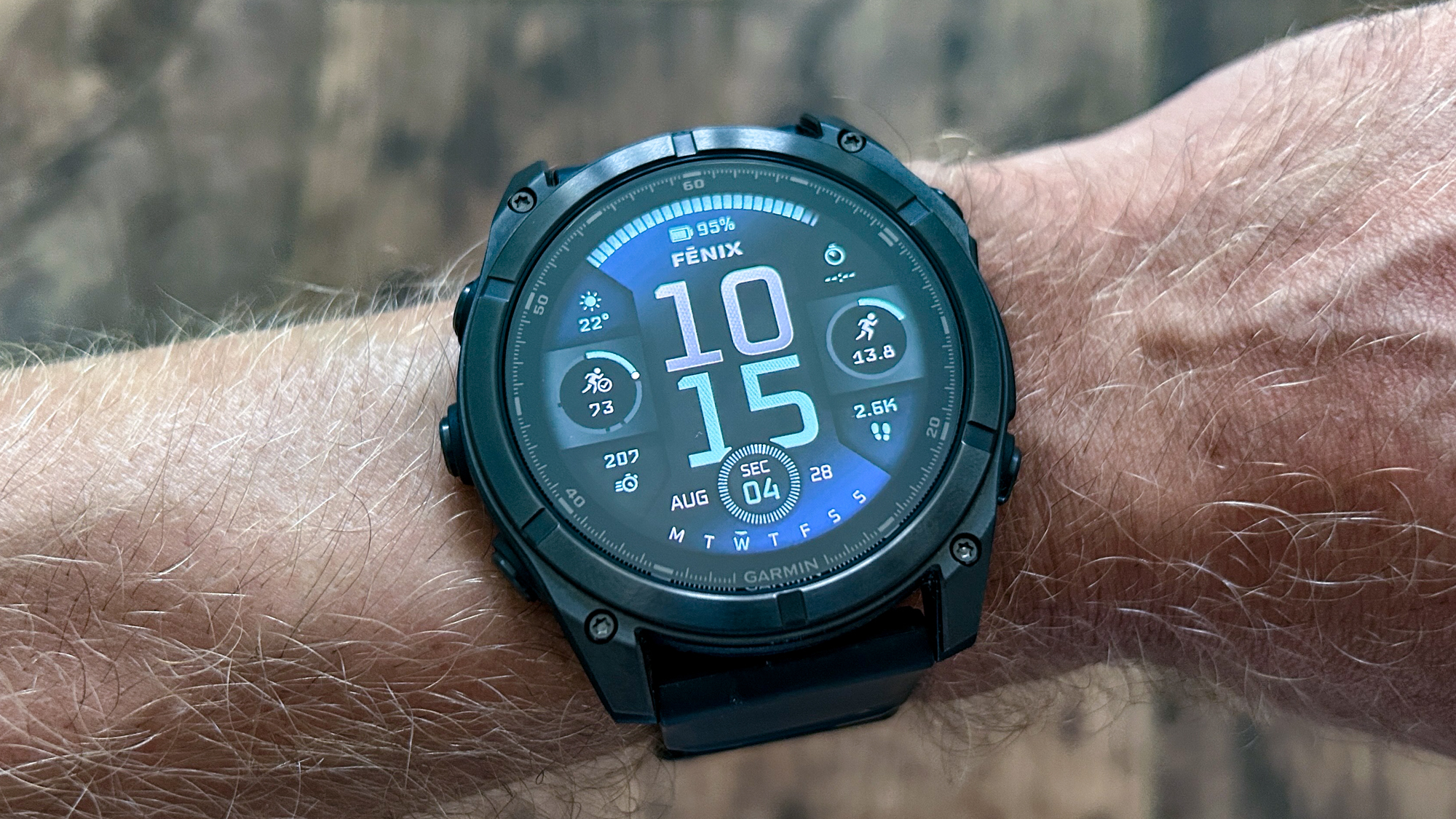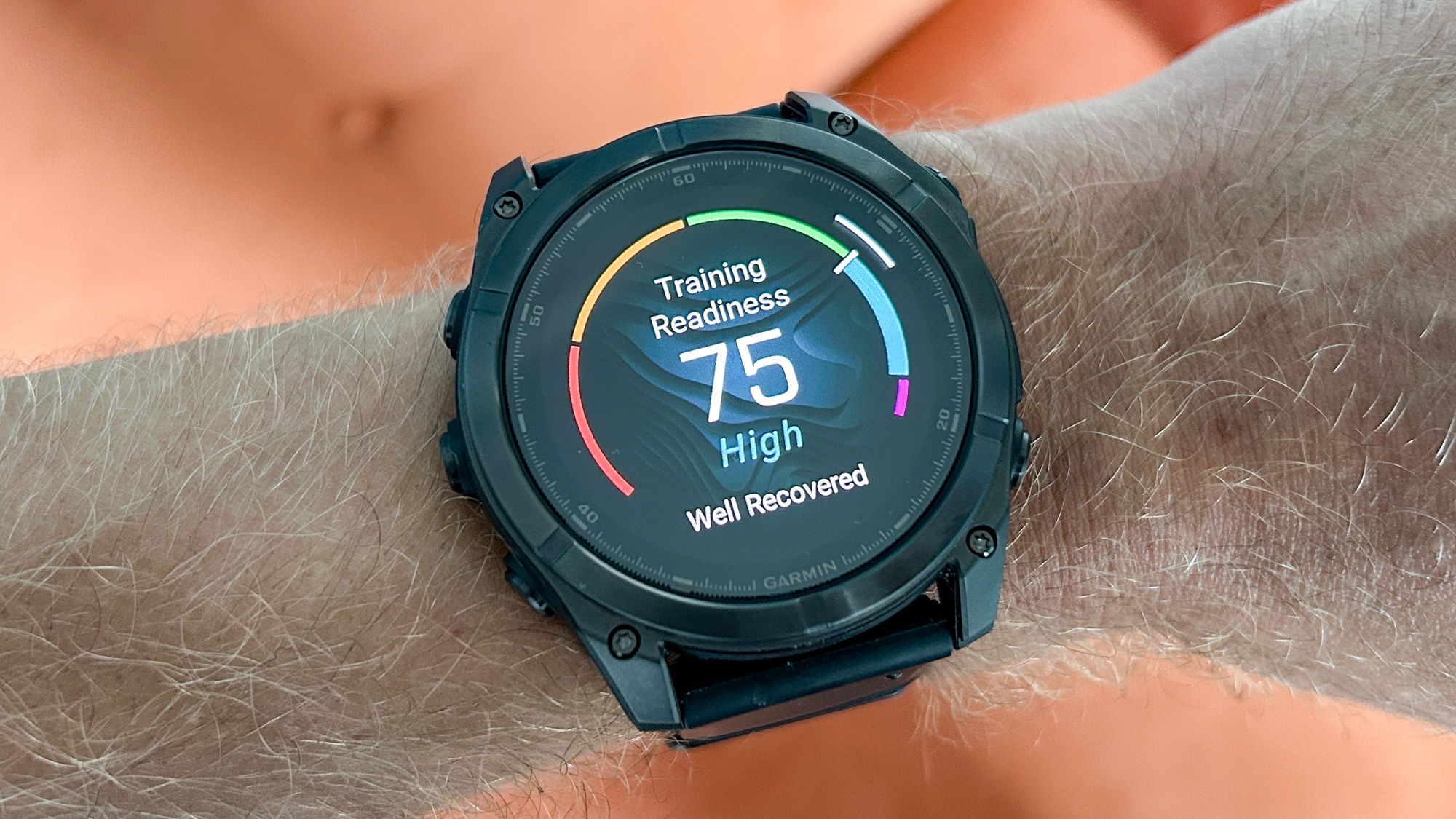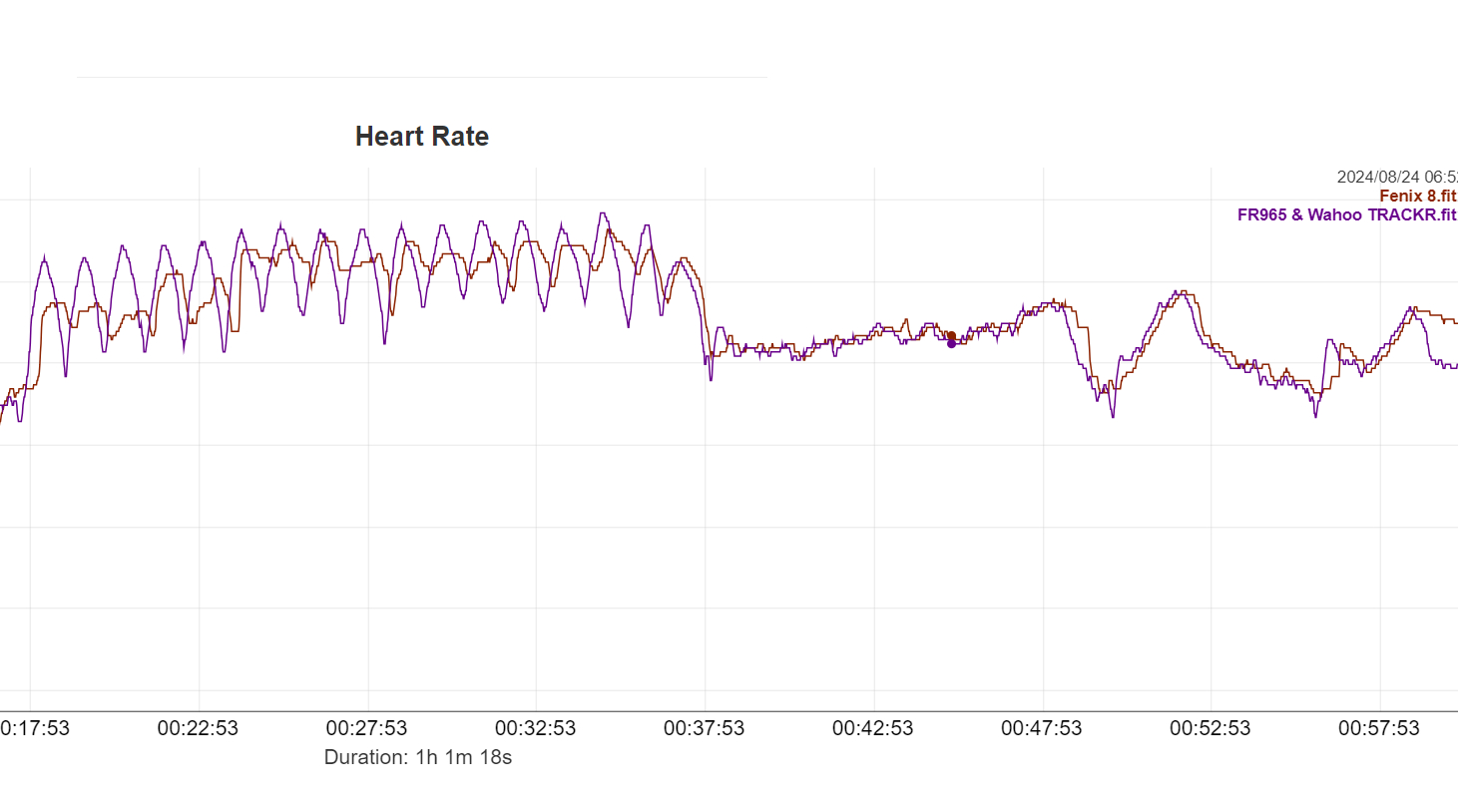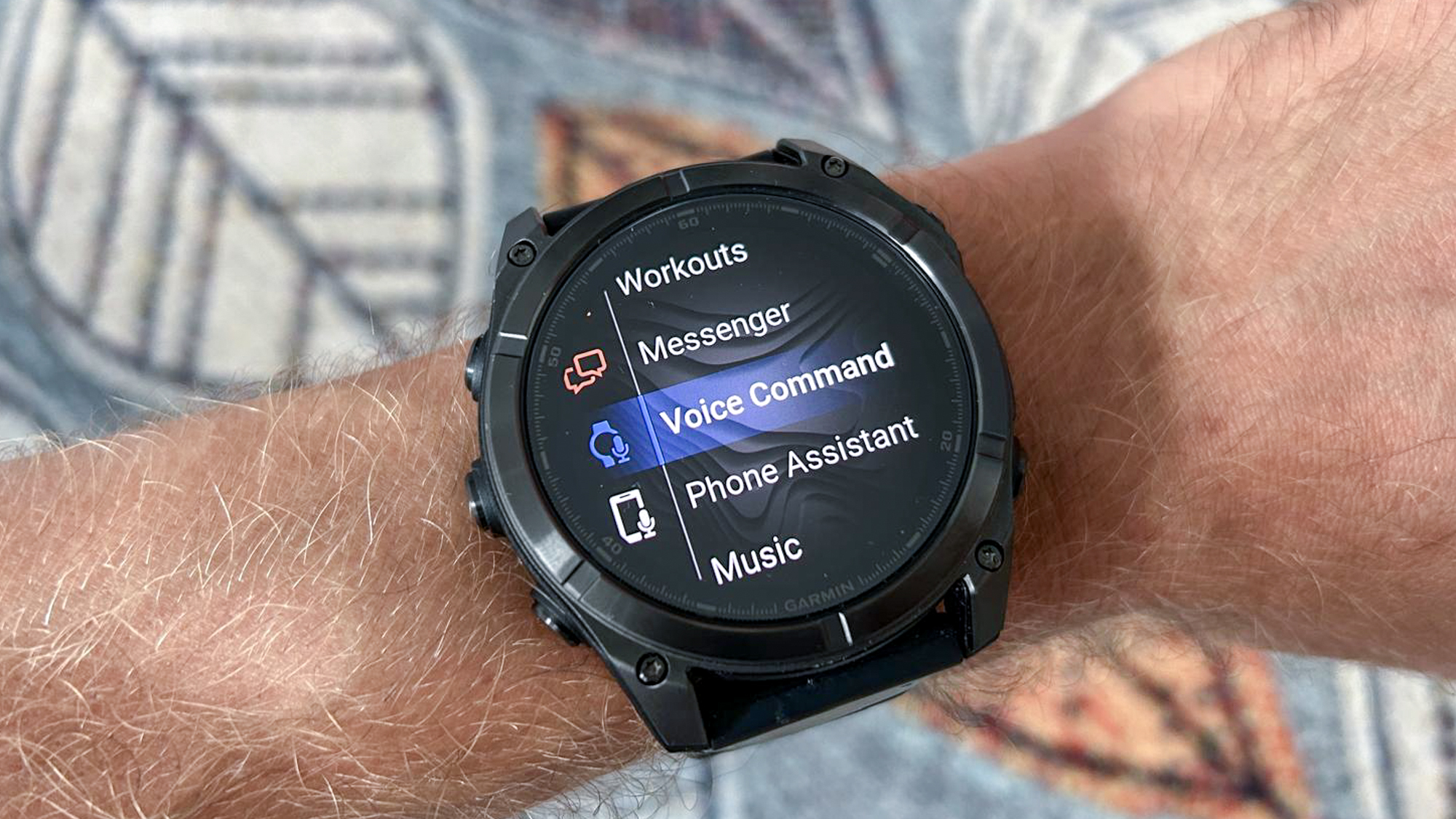
The Garmin Fenix 8 brings the Garmin Fenix 7 Pro and Garmin Epix Pro under one banner, meaning that for the first time you can buy a Garmin Fenix with an AMOLED screen. There is still the option of a traditional memory-in-pixel display on the Garmin Fenix 8 solar, which also has solar-charging to boost battery life.
Other upgrades with the Fenix 8 include a new mic and speaker, plus a more waterproof design that can be used for diving to depths of 40m. Garmin has also updated the user interface and navigation features on the watches, and increased the battery life.
I’ve been testing the Garmin Fenix 8 AMOLED 51mm watch for several weeks, and the updates means that the Fenix 8 is the best smartwatch available for those who do a lot of sports. However, older Garmin models like the Epix Pro and Fenix 7 Pro still offer most of the features on the Fenix 8, and could represent better value. As could the new Garmin Fenix E, which launched at the same time as the Fenix 8 as a more affordable option.
In my full Garmin Fenix 8 review I'll explain why I think it's the best Garmin watch and compare it to other top sports watches including older Garmin models you might be able to find on sale.
Garmin Fenix 8 cheat sheet
- Release date: The Garmin Fenix 8 launched on August 27, alongside the Garmin Enduro 3
- Price: The Fenix 8 costs from $999.99 to $1199.99, depending on the model and size you pick
- What’s new? AMOLED screen, built-in microphone and speaker, 40m dive rating, leakproof buttons
- Key features: AMOLED or solar-charging, offline maps, music storage, dual-band GPS, flashlight
- Garmin Fenix 8 or Enduro 3? The Enduro 3 offers longer battery life, but there’s no AMOLED option and it doesn’t have a mic and speaker.
- Garmin Fenix 8 or Fenix E? The Fenix E is $799.99 and only comes in the 47mm size. It doesn’t have Garmin’s latest heart rate sensor, or the mic and speaker and flashlight on the Fenix 8.
Garmin Fenix 8 review: price and availability

The Garmin Fenix 8 launched on August 27 and is available now. The watch costs from $999.99 to $1199.99, depending on which model and size you opt for. There is also a cheaper Fenix E model that costs $799.99.
There are two options in the Fenix 8 range — AMOLED or solar-charging, with the latter having a memory-in-pixel display that is less bright than AMOLED, but which improves the battery life. There are three sizes of the Garmin Fenix 8 AMOLED — 43mm, 47mm and 51mm, and two sizes of the Garmin Fenix 8 solar — 47mm and 51mm sizes.
The price has risen compared with the Garmin Fenix 7 Pro and Garmin Epix Pro, and the older Garmin watches might offer better value to those who don’t need the new mic and speaker or the dive capabilities of the Fenix 8. It's also more expensive than the Galaxy Watch Ultra ($640) and Apple Watch Ultra 2 (from $799).
Garmin Fenix 8 review: specs
Garmin Fenix 8 AMOLED specs
Garmin Fenix 8 Solar specs
Garmin Fenix 8 review: design
I have been testing the Fenix 8 AMOLED 51mm watch, which is quite large and heavy even with the titanium model, but even with my thin wrists you do get used to the size of the watch. The larger model offers incredible battery life for an AMOLED watch, but it’s worth noting the smaller, lighter 47mm watch has the same size screen as the 51mm. The watch comes with a silicone band, which I personally would swap out for a lighter Garmin UltraFit nylon band.
The bright AMOLED display is the same as on the Epix Pro watch and I do find it a big upgrade on the classic memory-in-pixel Garmin screens, especially when indoors or under cloud or tree cover outdoors. In bright sunlight the AMOLED screen is still clearly visible, and if you use the raise-to-wake feature to increase battery life the display turns on rapidly when you turn your wrist.
There are several new watch faces to use on the Fenix 8 and you can customize the colors and data shown extensively, with Garmin adding more color choice in particular with the new watch. You can also add more watch faces using the Connect IQ app store.
The new leakproof buttons on the Fenix 8 feel a bit different to past models, but still click reliably and satisfyingly, and there’s a small haptic buzz to reassure you that you have hit the button. I’ve not tested the diving sports modes, but the upgrade in water resistance is welcome.
You can activate the new mic using the menus on the watch or set it up as a shortcut so the watch starts listening when you hold a button. You can then use commands like set a timer and the Fenix 8 will process them. This takes a little longer than with smartwatches like the Apple Watch Ultra 2, but it’s a useful update.
The new speaker means you can take calls on the watch and it will also give voice updates during activities, such as your lap stats during a run — rest assured you can turn this off if you’d rather not have your watch talking to you during group activities.
All of the new Fenix 8 models have a built-in flashlight, which is very useful during and outside of activities at night. You also get this flashlight with the Epix Pro and Fenix 7 Pro ranges, but not the Garmin Epix 2 or smaller Fenix 7 models.
Garmin Fenix 8 review: sports tracking and training analysis

I’ve been running daily with the Garmin Fenix 8, as well as doing indoor bike rides on the Wattbike Proton a few times a week, plus strength and yoga sessions. The sports tracking experience on the watch is similar to that of other top Garmins like the Epix Pro and Fenix 7 Pro, which is to say it’s very good indeed.
There are sports modes for pretty much everything, including a dedicated track run and triathlon modes, with the latter including an auto transition feature for when you switch sports. You can customize all these sports modes to show the stats you want, and you can also follow structured workouts and full training plans on your wrist.
All your workouts feed into the detailed training analysis on the Fenix 8, which goes beyond the usual VO2 max and race time estimates you get from most sports watches these days. You get stats like your hill score and endurance score, which rate your climbing ability and overall endurance respectively, plus a breakdown of your training load so you can see if it’s balanced between different types of aerobic and anaerobic workouts.
Some people will find all this data more useful than others, but the fact it’s all there means you can dive into whatever is interesting to you at that time. In the past I’ve trained for a trail ultramarathon with a Garmin watch and was suddenly very interested in my hill score. Now I’m marathon training, I care about my endurance score more, and hope to see it climb as my training load gets more intense.
The watch also collates a lot of the stats its tracking into one Training Readiness rating, which is a handy gauge of the state of your body each day based on factors like recent workouts, sleep and your heart rate variability.
As you would expect from a top-of-the-range Garmin, the Fenix 8 delivers a comprehensive and useful slate of tracking and analysis features for athletes. If you are into your stats, there’s more info to analyze and enjoy than you get from other brands’ top watches. The same features are available on cheaper watches in the Garmin range, however, though there is a chance the Fenix 8 will get more updates in the future that may not always roll back to older devices.
Garmin Fenix 8 review: GPS & HR accuracy
To check the reliability of the GPS and heart rate tracking on the Fenix 8 I have compared it with other devices throughout my testing. To check the heart rate I did several runs where I also used the Wahoo TRACKR chest strap heart rate monitor, and I’ve been checking the GPS accuracy on the Fenix 8 against the tracks produced by other watches I’ve found very good for GPS — the Garmin Forerunner 965 and Garmin Enduro 3.
The GPS accuracy has been excellent for me. I’ve used the Fenix 8 in the most accurate multi-band mode, which drains battery life faster, for some runs, but done the majority in the AutoSelect mode, where the watch switches between GPS modes automatically to balance accuracy and battery life.
I’ve pored over the GPS tracks and they have all looked as expected, accurately tracing the route I took, even when I checked them before Garmin’s new feature that fixes dodgy GPS tracks after activities came into effect. In very hard GPS environments, like the center of big cities, the pace stats on the watch will jump around a little, but the Fenix 8’s accuracy was good even under tree cover.
The heart rate accuracy has also mostly been very good. In general I use a chest strap for the most accurate tracking possible during my runs in particular, but after three weeks of use I’ve rarely seen notable heart rate errors during my runs while using the Fenix 8’s optical heart rate monitor.
There have been some exceptions to this, in particular when doing interval sessions. I did a workout of 24 x 30-second hill reps and the Fenix 8 optical heart rate tracking wasn’t able to keep pace with the sharp ups and downs of my heart rate during that. This is a common problem for optical heart rate sensors on watches in my experience.

Overall, the tracking is good enough that you can go without an external sensor most of the time, but if you train using your heart rate or plan to use the training analysis extensively to guide your training, then using a chest strap would be beneficial because the analysis relies heavily on heart rate data from workouts.
Garmin Fenix 8: Battery life

The big advantage to the larger 51mm Fenix 8 AMOLED is that it offers significantly longer battery life than the 47mm model, and even with the screen set to always-on during and outside of activities the watch lasted me just shy of 13 days.
That’s incredible for an AMOLED watch, especially given that I was running every day using the GPS, as well as receiving notifications on the watch. It’s a few days longer than the 51mm Epix Pro would last me on a charge, and while the Enduro 3 I was testing at the same time as the Fenix 8 did outlast it, the Enduro was down to 22% when I had to charge the Fenix 8. That’s not a huge difference given the upgrade you get with the AMOLED display on the Fenix 8.
The big advantage sports watches like the Fenix have always had over smartwatches like the Apple Watch Ultra 2 is battery life, so it’s good to see that they can still offer such long battery life even with AMOLED displays.
Garmin Fenix 8 review: Maps and navigation
Although Coros, Polar and Suunto have all launched watches with color maps now, and Apple’s navigation features continue to improve, Garmin still leads the way in this area. The Fenix 8 has routable maps that will create routes for you on the fly, and clever round trip and back to start features that will guide you home even if you get lost mid-run.
You can create routes in the Garmin Connect app and sync them to the watch, or ask the watch to create some routes for you based on popular courses used by others. One of Garmin’s standout features is ClimbPro, which shows all the climbs and descents on your route individually so you can judge your effort accordingly.
ClimbPro is most useful for hilly runs and when I did a 14-mile trail run with over 4000ft of climbing it was invaluable for judging my efforts on the uphills — knowing how far you have left to the summit stops you from pushing too hard early in a climb, I find.
Garmin Fenix 8 review: smart features
The Garmin Fenix 8 doesn’t match the smart features you get from watches like the Apple Watch Ultra 2 or Samsung Galaxy Ultra, which have far more impressive app stores to call on and cellular connectivity.
For a sports watch, however, it is pretty smart, offering contactless payments through Garmin Pay, you can add music to your Garmin and there’s the ability to connect to streaming services Spotify, Amazon Music and Deezer, and a modest selection of apps in the Connect IQ app store.
There are also lots of watch faces in the Connect IQ app store, and more customization available on the preset options than with past Fenix and Epix watches, with Garmin allowing a wider choice of colors in particular.
It’s a sports watch first and foremost, but the smart features on the Fenix 8 are enough to put it ahead of most other sports watches, which don’t offer payments or music storage. The AMOLED display is also bright and engaging, and the touch controls are fluid on the watch with no lag.
Should You Buy The Garmin Fenix 8?
The Garmin Fenix 8 adds a few extra features to the already excellent package you got with the Garmin Fenix 7 Pro and Epix Pro, and if money is no object I’d say it’s the best sports watch you can get.
However, it’s very expensive and if you don’t need the new features then the core sports tracking experience on older Garmin models is just as good, and the Epix Pro or Fenix 7 Pro will be better value. The Garmin Forerunner 965 is another more affordable alternative that has a lighter, less rugged design, but all the main software features you get on the Fenix 8.
There are also cheaper options from other brands, like the Suunto Race and Suunto Race S in particular, which are both AMOLED sports watches with maps and good battery life. Garmin’s watches have more smarts and training analysis features. They have more features in general, but the Suunto Race S in particular is great value at $349 / £325.
Compared to the most sporty smartwatches like the Apple Watch Ultra 2 and Samsung Galaxy Ultra the Fenix 8 AMOLED offers much better battery life and more detailed and insightful sports tracking and training analysis. The navigation features on the Fenix 8 are also second-to-none, but it is not as smart as the best smartwatches, with the Connect IQ app store having far fewer apps than Apple and Google’s app stores in particular.







